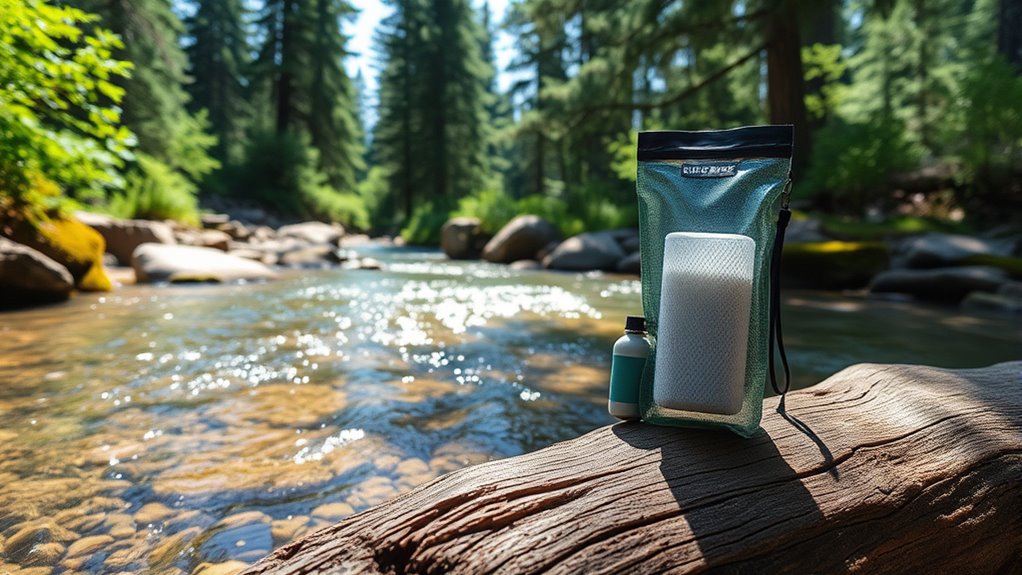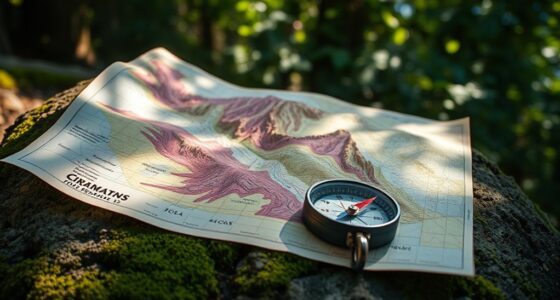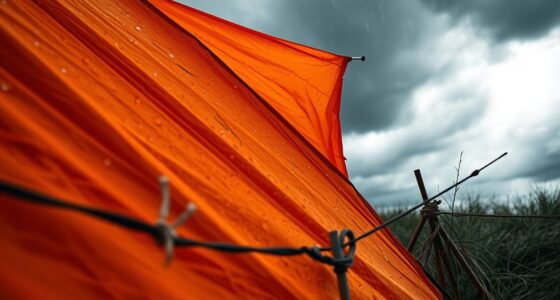To make backcountry water safe, you can use mechanical filters to remove sediment and bacteria, or combine them with chemical disinfectants like iodine or chlorine tablets for added protection. Boiling water is a reliable method for killing pathogens, while UV-C light devices offer chemical-free purification. Often, using multiple techniques together guarantees the freshest, safest water possible. Keep exploring to discover detailed steps on choosing and correctly applying these methods in the wilderness.
Key Takeaways
- Use mechanical filters like pump or gravity filters to remove debris, bacteria, and improve water taste before chemical or UV treatment.
- Combine filtration with chemical disinfectants (iodine, chlorine tablets) or UV-C light to enhance pathogen elimination.
- Boiling water for at least one minute effectively kills bacteria, viruses, and protozoa, but does not remove chemicals or sediments.
- Regularly maintain and replace filters according to manufacturer guidelines to ensure optimal performance and safety.
- Conduct a multi-stage filtration process, starting with sediment removal followed by chemical or UV disinfection for comprehensive safety.
Understanding Water Contaminants in the Wilderness

When you’re out in the wilderness, understanding water contaminants is essential for staying safe. Waterborne pathogens like Giardia, Cryptosporidium, and bacteria can cause serious illnesses if ingested. These microorganisms often come from animal waste, contaminated runoff, or infected wildlife. Chemical contaminants, such as pesticides, heavy metals, and industrial chemicals, can also pollute water sources, posing health risks. These chemicals might originate from agricultural runoff or environmental pollution. Recognizing that water sources can harbor both biological and chemical threats helps you stay vigilant. Always assume untreated water could contain harmful pathogens or chemicals. Proper knowledge of these contaminants guides your filtration and purification choices, ensuring you avoid illness and enjoy your outdoor adventure safely. Expert advice can help you select the most effective methods for your situation.
Mechanical Filtration Techniques
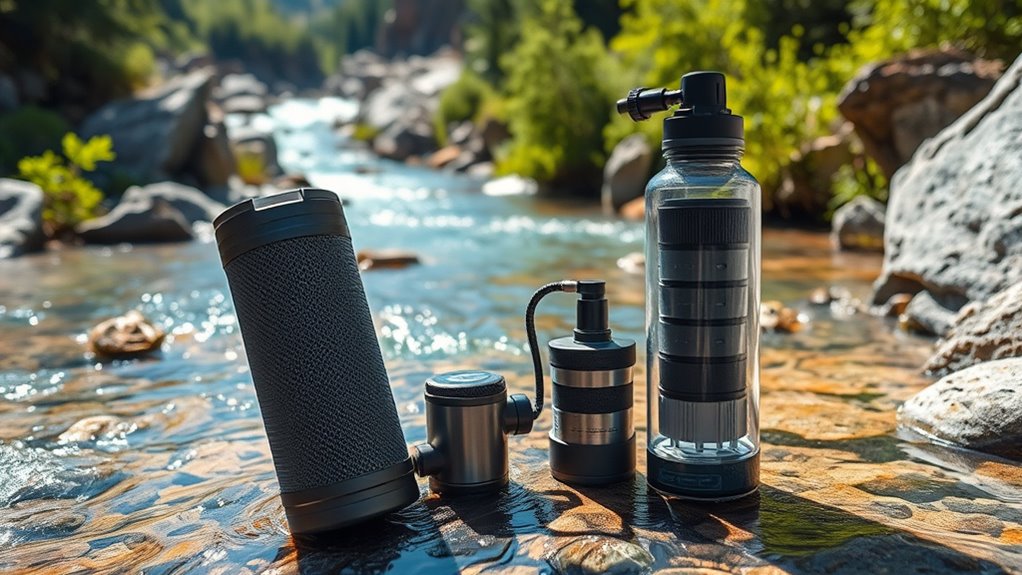
Mechanical filtration devices come in various types, like pump filters, gravity filters, and straw filters, each suited for different situations. To guarantee safe drinking water, you need to use proper filtration techniques, such as pre-filtering and avoiding cross-contamination. Regular maintenance and timely replacement of filter elements are essential to keep your system effective and reliable. Additionally, understanding HEPA Filtration and its role in removing tiny particles can help you select the most effective filtration method for your needs.
Types of Filter Devices
Have you ever wondered how water filters remove harmful particles from natural sources? The key lies in different filter devices designed for portability and efficiency. Portable pumps are compact, hand-powered devices that allow you to manually pump water through a filter, removing dirt and bacteria on the spot. Gravity filters, on the other hand, rely on gravity to pull water through a filter cartridge, making them ideal for group camping or longer trips. They don’t require manual effort once set up, providing a continuous flow of clean water. Both types typically feature multiple filtration layers, including fine screens and activated carbon, to eliminate particulates and improve taste. Choosing between these depends on your needs, but both are effective mechanical filtration tools for backcountry water safety.
Proper Filtration Techniques
To guarantee effective removal of particles and pathogens, it’s essential to follow proper filtration techniques when using mechanical water filters. First, use a portable pump to draw water through the filter. Before filtering, inspect and clean the pre filter screen to remove debris and prevent clogging. Make certain the screen is securely attached and free of obstructions. When filtering, maintain steady pressure to avoid damaging the filter elements. Keep the flow rate consistent to maximize filtration efficiency. Always filter water away from potential contaminants like mud or sediment, and avoid squeezing the filter excessively. After use, store the filter properly to prevent damage. Following these techniques ensures your filter works effectively and prolongs its lifespan during your backcountry adventures.
Maintenance and Replacement
Regular maintenance and timely replacement are essential to guarantee your water filter continues to perform effectively. You should regularly inspect your filter for signs of clogging or wear, which can hinder water flow and reduce filtration efficiency. Follow the replacement schedules recommended by the manufacturer, usually every few months or after filtering a certain volume of water. Proper filter maintenance involves cleaning or backflushing, if applicable, to remove debris and extend its lifespan. Keep track of usage dates to ensure you replace filters on time, preventing contamination or reduced water quality. Neglecting maintenance can lead to bacterial growth or filter breakdown, compromising your safety. Additionally, understanding filter lifespan helps in planning replacements and maintaining water quality. Staying diligent with filter maintenance and replacements ensures you always have access to clean, safe water while backpacking or camping.
Chemical Purification Methods
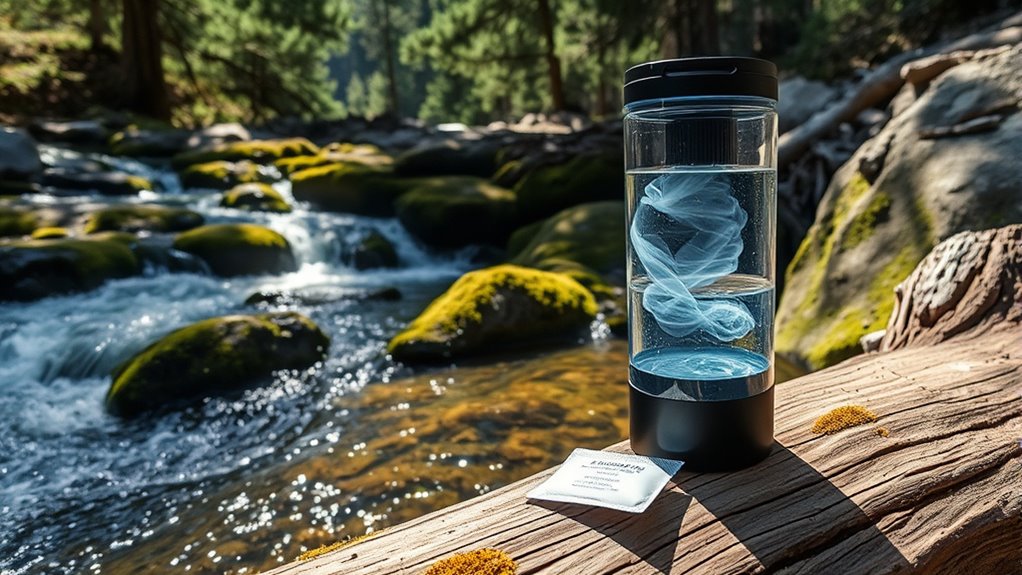
Chemical purification methods offer a practical way to make contaminated water safe for drinking when other filtration options aren’t available. You use chemical disinfectants like iodine or chlorine tablets to kill bacteria, viruses, and protozoa through chemical reactions that disrupt their cellular functions. These methods are quick and lightweight, making them ideal for backcountry use. To guarantee effectiveness, you must follow the correct dosages and wait the recommended contact time, usually around 30 minutes. Keep in mind that some chemical disinfectants may leave an aftertaste, and certain contaminants like heavy metals or chemicals might not be removed. Always combine chemical purification with pre-filtration if water is murky to improve contact and ensure safe, drinkable water. Proper disinfection techniques are essential to eliminate pathogens effectively and prevent waterborne illnesses.
Ultraviolet (UV) Light Treatment
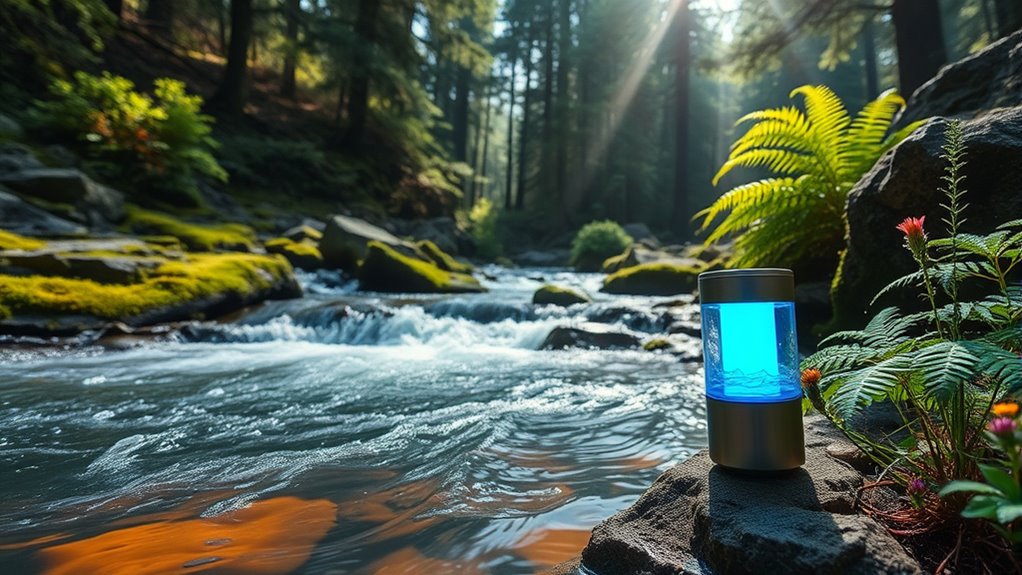
UV light treatment uses ultraviolet radiation to effectively disinfect water by destroying bacteria, viruses, and protozoa. To get the best results, you need to understand how UV devices work and follow proper usage instructions. When used correctly, UV systems provide a quick, chemical-free way to ensure safe drinking water in the backcountry. Additionally, understanding AI safety measures can help ensure the proper deployment and maintenance of UV systems for optimal performance.
How UV Disinfects Water
Ultraviolet (UV) light treatment works by damaging the DNA or RNA of microorganisms in water, rendering them unable to reproduce or cause infection. This process, known as UV sterilization, effectively inactivates bacteria, viruses, and protozoa through direct exposure to UV light. When you pass water through a UV device, the UV rays penetrate the cell walls of microbes, disrupting their genetic material and preventing their survival. Because UV disinfection targets microorganisms without adding chemicals, it leaves no chemical residues behind. UV sterilization is quick and efficient, making it ideal for backcountry use where reliable, chemical-free disinfection is essential. Remember, for UV disinfection to work properly, the water must be clear, so particles that block UV rays need to be filtered out beforehand. Proper equipment maintenance ensures the UV system continues functioning effectively.
Proper UV Device Use
To guarantee effective water disinfection with a UV device, you need to follow proper usage guidelines carefully. First, verify your portable purifier’s UV bulb is clean and functioning correctly. Fill the container with water, removing any particles or sediment that could block UV rays. Shake or stir the water to expose all areas evenly. For solar sterilization, position the water in a clear, transparent container under direct sunlight for several hours, but note that UV devices provide faster, more reliable results. Always follow the manufacturer’s instructions regarding exposure time, typically around 60-90 seconds per liter. Remember, UV treatment doesn’t remove chemicals or sediments, so combine it with filtration if needed. Proper use maximizes the device’s effectiveness and ensures safe drinking water in the backcountry. Using a UV-C light technology device can significantly enhance disinfection efficiency when used correctly.
Boiling and Its Effectiveness

Boiling water is one of the most straightforward and reliable methods to eliminate harmful pathogens in outdoor settings. Its main advantage is its simplicity; you only need a heat source and a container. Boiling kills bacteria, viruses, and protozoa effectively, making it highly trusted for safety. The boiling advantages include quick results and minimal equipment needed. However, boiling also has limitations. It doesn’t remove chemical contaminants, heavy metals, or sediments, so if your water is polluted with chemicals, boiling alone won’t suffice. Additionally, it requires fuel and time, which can be scarce in remote areas. Despite these limitations, boiling remains one of the most accessible and dependable methods for ensuring water safety when used correctly. High-quality projectors can improve visibility and make it easier to monitor water boiling processes in outdoor environments.
Combining Methods for Optimal Safety

While boiling effectively kills most pathogens, it doesn’t remove chemical contaminants or sediments. To guarantee water safety, combining methods is your best bet. Start with filtration to remove sediments and debris, then use chemical treatment or mechanical filters for additional protection. Portable solutions like lightweight filters or chemical tablets are convenient in the field. Chemical methods excel at neutralizing viruses and chemicals, while mechanical filters are great for sediments and bacteria. For ideal safety, consider this table:
| Method | Best Use |
|---|---|
| Chemical | Removing chemicals and viruses |
| Mechanical | Filtering sediments and bacteria |
| Combined Approach | Ensuring thorough water safety |
| Boiling | Killing pathogens |
Mixing these techniques maximizes safety, especially when water quality is uncertain. Incorporating multi-stage filtration can further enhance water purity by targeting various contaminants in sequence.
Frequently Asked Questions
How Do I Choose the Best Water Filtration System for My Trip?
You should choose a water filtration system based on your trip length and water sources. Portable filters are great for quick, easy filtration of bacteria and protozoa, perfect for hiking. Chemical purifiers work well for treating larger quantities and removing viruses, ideal for longer trips or uncertain water quality. Consider weight, speed, and ease of use to pick the best option, ensuring safe, clean water wherever you go.
What Are the Signs of Waterborne Illnesses to Watch For?
You should stay alert for symptoms awareness like nausea, diarrhea, vomiting, and stomach cramps, which are common signs of waterborne illnesses. Watch for fever, fatigue, or dehydration too. If you notice these symptoms after drinking untreated water, seek medical attention promptly. Recognizing illness identification early helps prevent complications. Always trust your instincts—if something feels wrong, get tested and hydrate properly to stay safe in the backcountry.
Can Chemical Purifiers Improve Water Taste?
Chemical purifiers can improve water taste by eliminating unpleasant odors and contaminants, but they may also cause a chemical taste that some find off-putting. While they’re effective at neutralizing bacteria and viruses, their effectiveness depends on proper usage and contact time. To reduce the chemical taste, you can let the water sit or add a pinch of salt. Overall, chemical purifiers boost safety and can enhance water flavor when used correctly.
How Long Does UV Water Treatment Take?
UV water treatment typically takes about 60 seconds of ultraviolet timing to effectively neutralize harmful pathogens. The treatment duration depends on the clarity of your water—cloudier water might need a longer exposure. Make certain your UV device is properly calibrated and follow the manufacturer’s guidelines. For maximum safety, verify the water is clear and agitate it during treatment to maximize contact with the UV light, ensuring thorough purification.
Are There Environmentally Friendly Water Purification Options?
Yes, there are eco-friendly water purification options. You can choose eco-friendly filtration systems that use sustainable materials or biodegradable purifiers that break down naturally without harming the environment. These options often consume less energy and reduce plastic waste, making them ideal for outdoor enthusiasts. By selecting biodegradable purifiers and eco-friendly filtration methods, you help protect natural water sources while ensuring safe drinking water during your adventures.
Conclusion
So, next time you venture into the wild, remember that trusting your instincts alone isn’t enough—unless you’re okay with risking a not-so-fun trip to the doctor. Whether you filter, purify, or boil, each method plays a part in keeping you healthy. After all, nothing says “adventure” quite like fighting off waterborne bugs—because who needs clean water when you can have a memorable story of illness instead? Stay safe, stay smart.
